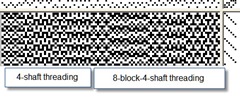Posted by Peg in South Carolina
Dear reader: if you make it to the end of this piece without your eyes glazing over, you are a better person than I.
On Friday I had written about a float issue with the 8-blocks-on-4-shafts crackle structure when treadling it polychrome. This issue was that some of the blocks have floats in two successive treadlings when treadling polychrome. Go here to see more specifically what I had to say. And the question I left off with was:
Now I am wondering if I can change the threading of blocks with two consecutive weft floats so that there is a weft float on only one treadle?
Yesterday I did just that. And I discovered that it is impossible to change the threading on any of the blocks, whether or not it has two neighboring floats.
THE THREADING
Here are the eight threading blocks in this structure. Technically they are really units rather than blocks because they do not act independently of each other. So even though I visualize the design in terms of blocks, I will call them units. The number in parentheses for each unit is the incidental/accidental thread that must occur when you move on to the next unit. When a unit is repeated six times, for example, each time only the first four numbers are threaded. But on the last repeat, just before moving to the next unit, the number in parentheses must be inserted in order to maintain the underlying tabby structure.
Unit 1: 1,4,2,4 (1)
Unit 2: 4,2,1,2 (4) compare 1,2,1,4 in standard 4-shaft crackle
Unit 3: 2,1,3,1 (2)
Unit 4: 1,3,2,3 (1) compare 1,2,3,2 in standard 4 shaft crackle
Unit 5: 3,2,4,2 (3)
Unit 6: 2,4,3,4 (2) compare 2,3,4,3 in standard 4-shaft crackle
Unit 7: 4,3,1,3 (4) compare 1,4,3,4 in standard 4-shaft crackle
Unit 8: 3,1,4,1 (3)
The basis of each crackle unit is a mini-point twill. Zielinski, however, has stretched those limits in units 1, 3, 5, and 8 in order to get the extra four blocks. What he does retain, however, in those blocks is the 3 end limit for weft floats. The second limit he maintains is the limit to only one incidental thread between each different unit unit. Bearing in mind these limits, I quickly discovered that the 8 units here use up all the possibilities.
But I had jumped the gun a bit. I looked at the threading for the 4 units of regular 4-shaft crackle. Those units are in the right-hand column above. Each of those is very close one of the units in the 8-blocks-on-4- shafts structure. But the little point twill is inverted. So I added these normal 4-shaft crackle units (each one repeated twice) to the left side of the draft to see what happened.
shafts structure. But the little point twill is inverted. So I added these normal 4-shaft crackle units (each one repeated twice) to the left side of the draft to see what happened.
MUCH ADO ABOUT TIE-UPS
What happens is that those four blocks on the left do not really look like crackle. Why? The tie-up is the same. Whoops, no they are not. Not exactly. The same treadles are tied up but the order is  different from the order I would use for traditional four shaft crackle.
different from the order I would use for traditional four shaft crackle.
To the left is the tie-up I have been using on my current crackle project and is the tie-up for the draft directly above.
But the tie up for the usual 4 shafts crackle is different. This tie-up would be 1,2; 2,3; 3,4, 4,1; followed by the tabby tie-ups of 1,3 and 2,4.
The next question, then, is what would happen if I changed the tie-up to the 4-shaft crackle tie up in order to change the treadling order?
The results are the draft on the right. On the left iof that draft is the traditional crackle line that happens with 4-shaft crackle treadled polychrome. But something quite different is happening to the rest of the fabric.
All this suggests to me that trying to swap out a non-traditional crackle unit on the left for the one to its right would result in a very confusing fabric, no matter which tie-up I used. Besides, swapping out units would not solve the original float issue.
So I went back to Zielinski and I found something strange. Sometimes he uses this second tie-up. Sometimes he uses the first tie-up. Apparently it does not matter? I looked at the draft with the traditional tie-up more carefully. The double floats on consecutive treadles do not appear.
Case closed.
I will change the tie-up order, which, in effect, simply changes the treadling order.
My brain is dead.
I am so ready to weave.



1 comment:
Maybe Blogger will let me leave a comment today. I had a bit, long comment written out for your previous post, only to be frustrated by error messages. :(
Anyway, I'm paying attention!
Post a Comment